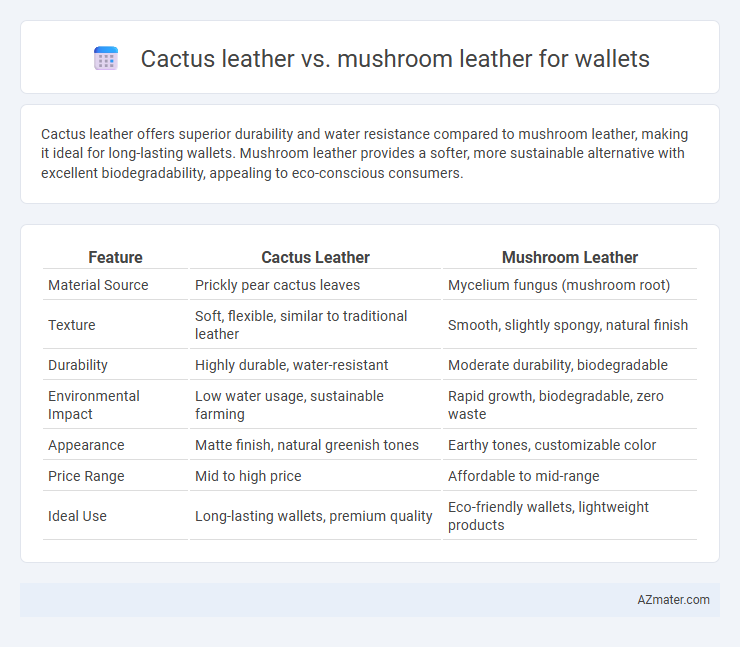Cactus leather offers superior durability and water resistance compared to mushroom leather, making it ideal for long-lasting wallets. Mushroom leather provides a softer, more sustainable alternative with excellent biodegradability, appealing to eco-conscious consumers.
Table of Comparison
| Feature | Cactus Leather | Mushroom Leather |
|---|---|---|
| Material Source | Prickly pear cactus leaves | Mycelium fungus (mushroom root) |
| Texture | Soft, flexible, similar to traditional leather | Smooth, slightly spongy, natural finish |
| Durability | Highly durable, water-resistant | Moderate durability, biodegradable |
| Environmental Impact | Low water usage, sustainable farming | Rapid growth, biodegradable, zero waste |
| Appearance | Matte finish, natural greenish tones | Earthy tones, customizable color |
| Price Range | Mid to high price | Affordable to mid-range |
| Ideal Use | Long-lasting wallets, premium quality | Eco-friendly wallets, lightweight products |
Introduction to Plant-Based Leathers
Plant-based leathers, such as cactus leather and mushroom leather, represent innovative, sustainable alternatives to traditional animal leather, minimizing environmental impact through renewable materials. Cactus leather, derived from mature nopales, offers durability and water resistance, while mushroom leather, made from mycelium--the root structure of fungi--provides a soft, flexible texture with rapid biodegradability. Both materials support eco-conscious consumers seeking vegan wallet options that combine style, sustainability, and advanced plant-based manufacturing technologies.
What is Cactus Leather?
Cactus leather is an innovative, sustainable material made from the leaves of the nopal cactus, prized for its durability and eco-friendly production process that uses minimal water and no harmful chemicals. It offers a cruelty-free alternative to traditional leather, featuring a natural texture that softens over time while maintaining water resistance and breathability. Compared to mushroom leather, cactus leather boasts greater robustness and longevity, making it especially suitable for everyday items like wallets.
What is Mushroom Leather?
Mushroom leather, derived from mycelium--the root structure of fungi--is an innovative, sustainable alternative to traditional leather, offering a biodegradable and eco-friendly option for wallets. This material mimics the texture and durability of animal leather while significantly reducing environmental impact due to its low water and chemical usage during production. Compared to cactus leather, which is plant-based and also sustainable, mushroom leather stands out for its rapid growth cycle and potential for customization in texture and thickness.
Sustainability Comparison
Cactus leather and mushroom leather both offer sustainable alternatives to traditional animal leather, with cactus leather derived from mature cactus leaves that require minimal water and no pesticides, reducing environmental impact. Mushroom leather, primarily made from mycelium, grows rapidly using agricultural waste, emphasizing biodegradability and low carbon footprint. While cactus leather boasts durability and water resistance ideal for long-lasting wallets, mushroom leather excels in compostability, making both materials strong contenders in eco-friendly fashion choices.
Durability and Longevity
Cactus leather offers robust durability due to its dense fiber structure, making it highly resistant to wear and tear, which ensures long-lasting use in wallets. Mushroom leather, while eco-friendly and biodegradable, tends to have a softer and more delicate texture that may show signs of wear sooner under frequent handling. Both materials provide sustainable alternatives to animal leather, but cactus leather is generally preferred for wallets requiring enhanced longevity and resilience.
Texture and Aesthetic Appeal
Cactus leather features a smooth, slightly glossy surface with a natural grain that mimics traditional leather, offering a sleek and sophisticated look for wallets. Mushroom leather presents a more fibrous texture with subtle variations and a matte finish, providing an organic, earthy aesthetic that appeals to eco-conscious consumers. Both materials deliver unique tactile experiences, with cactus leather tending toward softness and mushroom leather offering a slightly firmer, textured feel.
Production Process and Environmental Impact
Cactus leather production involves harvesting mature cactus leaves, which are dried, ground, and combined with non-toxic polyurethane to create a durable, biodegradable material with low water consumption. Mushroom leather is derived from mycelium, the root structure of mushrooms, grown in controlled environments using organic waste, resulting in a fully biodegradable and compostable product with minimal greenhouse gas emissions. Both materials significantly reduce reliance on animal leather, but cactus leather typically uses less energy while mushroom leather offers faster biodegradability, making each a sustainable alternative for eco-friendly wallets.
Cost and Market Availability
Cactus leather typically costs more due to its established production methods and higher demand in the sustainable fashion market, while mushroom leather offers a more affordable option as it is still emerging with scalable yield improvements. Market availability favors cactus leather, which is widely distributed globally through numerous brands and retailers, whereas mushroom leather remains niche, with limited manufacturers primarily in experimental or premium segments. Both materials appeal to eco-conscious consumers, but cactus leather's broader market penetration and consistent cost structure enhance its accessibility for wallet production.
Pros and Cons: Cactus Leather vs Mushroom Leather
Cactus leather offers superior durability, water resistance, and a lower environmental impact due to minimal water usage in cultivation, making it ideal for long-lasting wallets. Mushroom leather, derived from mycelium, provides exceptional biodegradability and a softer, more flexible texture but tends to be less water-resistant and less durable over time. Both materials are sustainable alternatives to animal leather, with cactus leather excelling in toughness and water resistance, while mushroom leather appeals for its eco-friendly biodegradability and unique softness.
Choosing the Best Eco-Friendly Leather for Wallets
Cactus leather offers exceptional durability and water resistance, making it ideal for wallets exposed to daily wear and tear, while mushroom leather excels in biodegradability and a softer texture that appeals to eco-conscious users seeking comfort. Both materials are vegan and sustainable alternatives to traditional leather, but cactus leather's carbon footprint is typically lower due to its low water and pesticide requirements during cultivation. Choosing the best eco-friendly leather depends on prioritizing either longevity and environmental impact, favoring cactus leather, or biodegradability and texture, where mushroom leather stands out.

Infographic: Cactus leather vs Mushroom leather for Wallet
 azmater.com
azmater.com